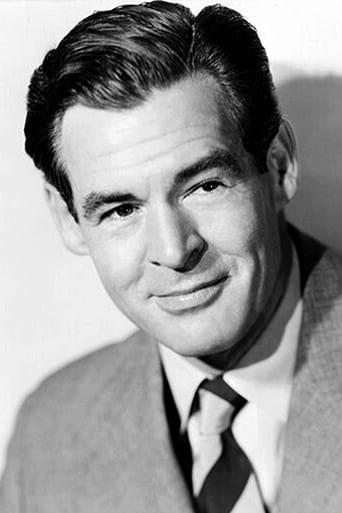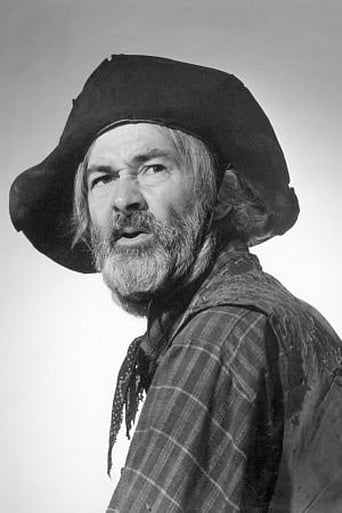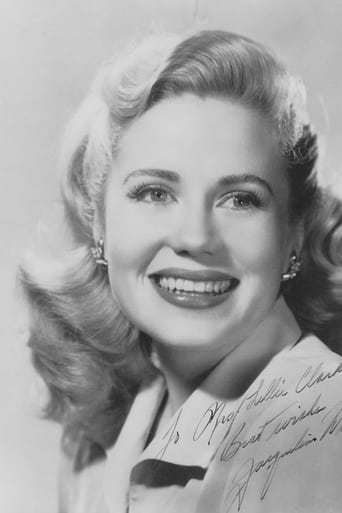Plantiana
Yawn. Poorly Filmed Snooze Fest.
MamaGravity
good back-story, and good acting
ShangLuda
Admirable film.
Borserie
it is finally so absorbing because it plays like a lyrical road odyssey that’s also a detective story.
Prismark10
Return of the Badmen is a crazy but a fun B western. It is a bit clichéd as Randolph Scott plays Vance Cordell a retired Texas Ranger hoping to settle down in Oklahoma which is just ripe for a land rush.The very best of outlaws are planning to just exactly that, a land grab as they converge to cause havoc. Led by the mean Sundance Kid (Robert Ryan) a world away from Robert Redford's portrayal. The outlaws also include Billy the Kid, the Younger Brothers, the Daltons, Wild Bill Yeager, Wild Bill Doolin. Vance manages to get one of the female outlaws to mend her ways and it also leads him to fight off two female admirers.Vance becomes a Marshall in order to take down the brutish Sundance Kid with a one on one fist fight.A likable, undemanding western.
zardoz-13
Randolph Scott plays a retired Texas Ranger who tangles with the notorious Sundance Kid in director Ray Enright's "Return of the Bad Men," set during the Oklahoma land rush of 1889. This fanciful 1948 western features some of the most notorious outlaws riding together in the same gang. Mind you, some of these ruffians never met each other, primarily Billy the Kid and Sundance. In fact, not that accuracy concerned scenarists Charles O'Neal, Jack Natteford, and Luci Ward, Sheriff Pat Garrett gunned down Billy the Kid in 1881. Scott plays his usual virtuous hero, while Robert Ryan is cast as Sundance. One character comments about Sundance as a friend: "He's a good man as long as you keep him in front of you." Ryan's Sundance murders men in cold blood and strangles a defenseless woman. This oater boasts better-than-average production values. Look at the number of U.S. Army troopers as well as the townspeople who throng the streets. "Mighty Joe Young" lenser John Roy Hunt's black & white cinematography is good. The screenplay lacks quotable dialogue and colorful incidents. Gabby Hayes provides comic relief but not as Scott's sidekick. Indeed, he plays a banker! Apart from Ryan's depraved outlaw, "Return of the Bad Men" qualifies as a predictable, standard-issue, horse opera with plenty of six-gun shoot-outs.After its introductory credits, this above-average RKO Radio Picture opens with a preface while villains are shown riding hard behind it. "These outlaws, famed in the history of the west, are riding to new riches and plunder—the Oklahoma of 1889. A whole new territory was about to spring up overnight. Ranchers, cattlemen, even whole towns—their land bought by the government—had been given thirty days to move else where. Land hungry pioneers were gathering for the race for free land. And behind them, waiting and ready for this rich prey, came the outlaws. Outlaw mastermind Wild Bill Doolin (Robert Armstrong of "King Kong") has assembled a name-dropping gang of desperadoes, among whom are the Younger Brothers (Steve Brodie, Richard Powers, Robert Bray), the Daltons (Lex Barker, Walter Reed, Michael Harvey) and Billy the Kid (Dean White) to rob the bank of Braxton. Doolin's niece Cheyenne (Anne Jeffreys of "Riffraff") delivers the news, and Sundance (Robert Ryan) and she abrade each other during their initial encounter. According to Cheyenne, everybody is leaving Braxton for the town of Gutherie. One of the residents, Vance Cordell, is in the middle of auctioning off his ranch. He plans to marry Madge Allen (Jacqueline White) after they clear out of the territory and move to California. Not only is Madge a widow, but also she has a son, Johnny (Gary Gray), who plays an integral part in the narrative. Madge works as a clerk at the local bank for her father. The bad men masquerade as cattlemen and convene a meeting with Bank President John Petti (George "Gabby" Hayes) in his office. Meantime, after Cheyenne relieves the local telegrapher of a warning message sent to Petti, she clobbers him and leaves him unconscious in a closet. George Mason (Warren Johson) keeps Petti and Madge at gunpoint while his accomplices rob the bank. Johnny walks past the window to Petti's office and notices Mason. The kid sounds the alarm and the townspeople converge on the bank. One of the outlaws, Mason, is gunned down in the street and Cheyenne catches a bullet but manages to getaway. Cordell has just left his ranch when he spots Cheyenne. He patches her up with the help of Grey Eagle (Charles Stevens of "Miguel Strogoff") and Dr. Greene (John Hamilton), and then lets her turn herself into the authorities. Sundance and his cronies ride into the ranch searching for Cheyenne. Sundance guns down the unarmed Grey Eagle. The outlaws catch up with Cordell, and Billy the Kid slips a lasso over him and drops him from the saddle. Sundance clubs Cordell over the head, frees Cheyenne, but Billy the Kid decides to leave them. He doesn't like Sundance's method of operation. Cheyenne rides along with Sundance and then double-crosses Sundance and Cole Younger. She decides to surrender to law. Before she turns herself in, Cheyenne takes the saddle bags of loot back to town. Secretly, she is fond of Cordell. Cordell accompanies Cheyenne into Braxton and she surrenders herself to affable Judge Harper (Jason Robards, Sr.). Cordell hands the bonds over to Petti. Cordell puts Madge and Johnny on the train for Gutherie and rides for Petti so he can get a good location in the the town of Guthrie. Enright stages the historic land rush without much fanfare.Before the U.S. Army exits Guthrie, Colonel Markham (Kenneth MacDonald) appoints a very reluctant Cordell as temporary U.S. Marshal. While Markham is trying to persuade our protagonist to pin on the badge, the stagecoach that the Sundance Kid and his cronies robbed trundles into Guthrie. When he learns the Sundance Kid shot one of the passengers on the coach, Vance changes his mind and accepts the badge. The big surprise occurs when Judge Harper shows up in Guthrie with Cheyenne. He wants to parole Doolin's niece into Cordell's custody as a telegrapher. Meantime, Doolin's gang has embarked on a lawless rampage. They are robbing banks and holding-up trains. Cordell has no luck catching them. Audaciously, Doolin and his gang have holed up in Braxton. Petti's friend Muley Wilson (William Baldwyn) tells him about seeing ghosts in Braxton. Petti mentions Muley's story to Vance. Cordell has Cheyenne, who calls herself Jeanne now, wire for more deputies. Cordell attacks Doolin and company and traps them in the Braxton saloon. Doolin torches a hay wagon and shoves it into the street to create a diversion so his men can flee. Nevertheless, Doolin is arrested. Eventually, Cordell and Sundance have a knock down, drag-out fistfight that Cordell winsThe cast is solid, and Enright reins "Return of the Bad Men" in at a lean 90 minutes.
MartinHafer
I love Randolph Scott films and have seen more than most people on the planet. However, while many of his films are bona fide classics, I am not some Kool-Aid drinker who believes every film he made is a work of pure genius. Yes, the Budd Boetticher and Sam Peckinpah films he made late is his career were amazingly entertaining and wonderful films, his films of the 1940s and early 50s were a mixed lot--some excellent and many like "Return of the Bad Men"--filled with clichés. Now I can't blame all the problems on Scott--he was, as usual, the consummate professional and his performance was his typical graceful job. But the script, sadly, wasn't much better than your average Gene Autry film--formulaic and a bit silly here and there.The film begins with Scott selling off his cattle and preparing to marry a blonde and move to California. However, the coming of some bandits put a crimp on this. Mostly, and this is so dumb, because he takes time out of his busy life to convince a FEMALE member of the bandits (?!!??) to give herself up and lead a life of virtue...SO SHE DOES!!! Were the writers on drugs?! A female member of the Sundance Kid's gang?! A bandit going straight because the virtuous hero asks her to?!?! What?!?!? Later, instead of getting married and moving, Scott accompanies the town as it picks up and moves a few miles away during the Oklahoma land boom. I have absolutely no idea why they did this....bored I guess. And, in this new town, Scott cannot leave because with all the new settlers they need law and order and he agrees to be the new Marshall--even though the plucky blonde widow wants him to live a simpler life since her first husband was a lawman...and he was killed (gosh!).Into this perennial waiting to get married come two problems. First, the reformed female bandit comes to town to be paroled to Scott (hmmm, that couldn't cause any problems). Second, now in addition to the tiny Sundance gang, lots of other famous bad guys come into the film. Yes, this one, at one point or another, has Sundance, the Daltons, Billy the Kid and 1001 other famous scum-bags all getting together to terrorize Oklahoma. It is patently ridiculous (since none of this ever happened)---and the sort of thing that drives history teachers (like myself) go crazy! By the end of the film, thanks to Scott, the gangs mostly disband. And, in a final showdown, it's just Scott versus the evil Sundance (Robert Ryan). Now, after a brief shoot-out, Scott manages to get the advantage on Sundance--holding him at gunpoint. So what does any cliché-driven film do now?! Yep...Scott throws down his guns and they punch it out, man-to-man!!! If it were me, I would have just shot Sundance in the face--after all, he murdered one of your friends and terrorized the territory!! Yep...shoot 'em in the face...none of this shooting him in his trigger hand or leg!! So why, if the film is so clichéd and inaccurate, do I still give it a 5? Well, as I said above, Scott is very good. Also, unlike too many of his westerns of the period, the stunt work is good--and you can't easily tell the stunt men are doing most of the dangerous stuff, as it's integrated well. Also, finally, it has Gabby Hayes. As usual, he's fun to watch and is a wonderful "old western coot"--also a cliché, but a fun one!
Mike Newton
The reviewer "krorie" from Van Buren, Arkansas, goes to great length to point out how historically Return of the Badmen were, listing the dates the different real life outlaws, depicted in the film, were living and when they died. While your research is to be commended, you missed the whole point of the movie. It was made for entertainment not enlightenment. Most of the westerns made by Hollywood took liberties with the facts and were presented in a fashion that audiences could accept. The Return of the Badmen, like its predecessor "Badmen Territory" used the combined villainy of real life western outlaws to add appeal to the western. While both films were made in the late Forties, and television had not yet made an effect on the movie going public, the genre was slowly being burned out. Everything possible had been tried in order to boost box office appeal. Actually, the B western was already suffering from postwar production costs, and ticket prices in those years right before television. Many families, particularly those with small children, did not have the money for a babysitter and so spent the evenings at home listening to radio. The movie westerns did their best box office at the Saturday afternoon matinées when parents dropped off their children at the theater so they could go shopping. While Randolph Scott made many westerns, these two westerns, particularly Return of the Badmen, must have made an impression on producer Mel Brooks because he uses Randolph Scott's name as an in-joke in his 1974 comedy Blazing Saddles. The townspeople are reluctant to help their new sheriff, who happens to be black, combat the outlaw hoards which is coming to their town. One person speaks up in defense of the sheriff by saying "You would help Randolph Scott" whereupon the people reverently repeat Scott's name as they take off their hats and are bathed in a heavenly light which shines from above.





